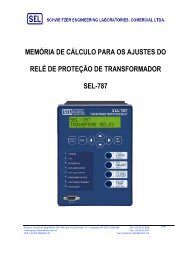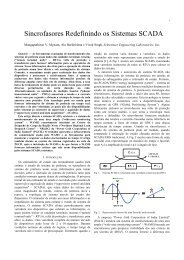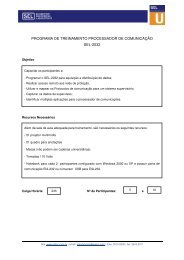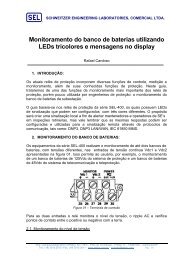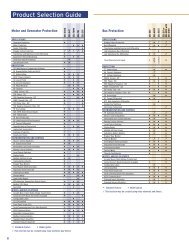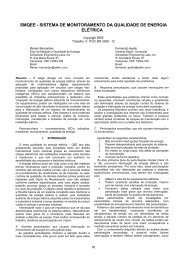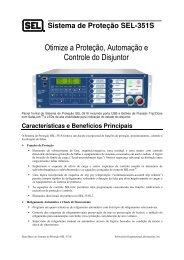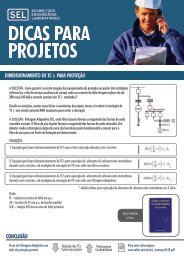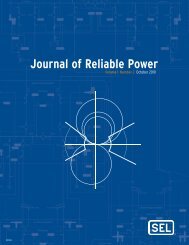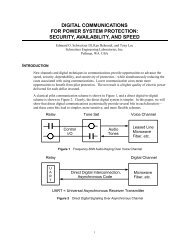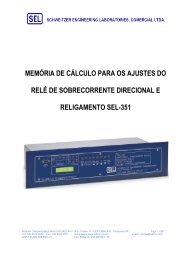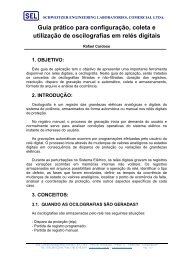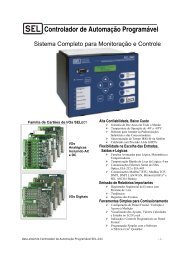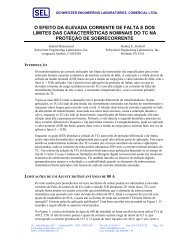Journal of Reliable Power - SEL
Journal of Reliable Power - SEL
Journal of Reliable Power - SEL
Create successful ePaper yourself
Turn your PDF publications into a flip-book with our unique Google optimized e-Paper software.
13<br />
Fig. 24 shows the apparent resistance for different Rf<br />
values for a fault at 70 percent <strong>of</strong> the line. Note that with<br />
Rset_zone1 equal to 11.52 ohms, the quadrilateral element can<br />
see 3 ohms secondary or 25 ohms primary.<br />
8<br />
7<br />
—— Rapp (ohms)<br />
Fault Resistance (ohms)<br />
6<br />
5<br />
4<br />
3<br />
2<br />
Rset = 11.52 ohms<br />
δ = 0 degrees<br />
1<br />
Fig. 24.<br />
Apparent resistance for a fault at 70 percent <strong>of</strong> the line<br />
Fig. 25 shows the margin <strong>of</strong> the selected Rset with respect<br />
to Rmax for the selected Zset.<br />
Fig. 25.<br />
Margin <strong>of</strong> Rset at Zset_zone1 equal to 0.7 pu<br />
Fig. 26 shows that the quadrilateral distance element can<br />
see up to 3 ohms for faults at 70 percent <strong>of</strong> the line for Rset<br />
equal to 11.52 ohms.<br />
0<br />
0 0.1 0.2 0.3 0.4 0.5 0.6 0.7 0.8 0.9 1<br />
Fault Location (pu)<br />
Fig. 26. Maximum Rf coverage with Rset equal to 11.5 ohms for faults<br />
along the line<br />
The analysis carried out for a phase-to-ground fault can<br />
also be applied for phase-to-phase faults. In these cases, the<br />
factor KR is equal to:<br />
1<br />
KR = (30)<br />
2 • C1<br />
For no-load conditions (δ equal to 0) and homogeneous<br />
systems, the resistive blinder <strong>of</strong> the phase quadrilateral<br />
element will assert for an Rf that satisfies (31) or (32).<br />
Rf<br />
( )<br />
Rset<br />
2 • Real C1 < (31)<br />
⎛ Vϕϕ<br />
⎞<br />
Rapp = Real⎜<br />
⎟ − m • Real ZL1<br />
⎝ Iϕϕ<br />
⎠<br />
( )<br />
(32)<br />
B. Zone 2<br />
When considering overreaching zones, it is important to<br />
determine the maximum underreach and verify that the zone<br />
covers at least the expected Rf. For example, in a Zone 2<br />
application, it is expected that all faults on the line and those<br />
at the remote terminal will be detected. It is a common<br />
practice to set the Zone 2 reach to 120 percent <strong>of</strong> the line<br />
length. However, in certain circumstances, this impedance<br />
reach would not guarantee coverage for faults with Rf, and a<br />
longer reach would be required.<br />
Adaptive Phase and Ground Quadrilateral Distance Elements | 77



